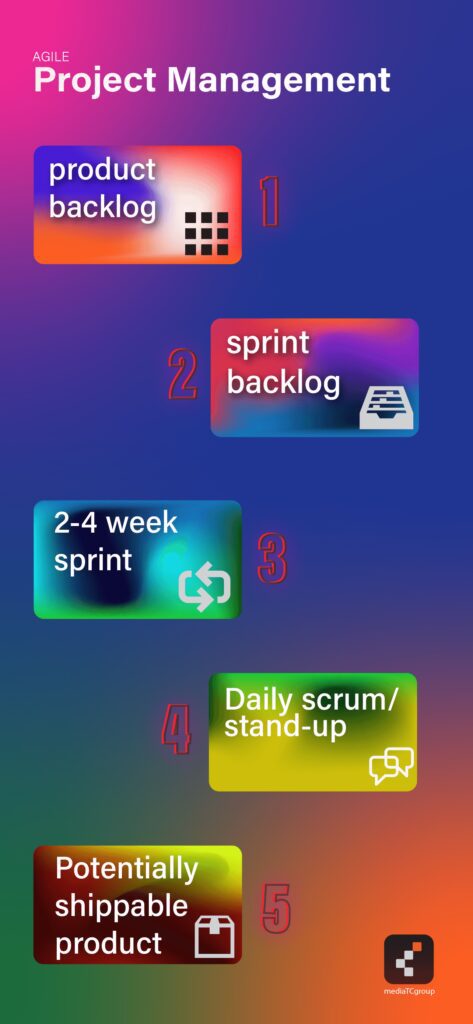What is an Agile Project Manager?
|
Tune in and get Inspired 🎧
Getting your Trinity Audio player ready...
|

Agile project management is a disciplined approach to software development that emphasizes flexibility, collaboration, and rapid feedback. By employing agile principles and practices, you can ensure that your projects are delivered on time, on budget, and with the highest quality possible. Whether you’re new to agile or an experienced practitioner, agile project management will help you be more effective and successful in your work.
Estimated reading time: 14 minutes
Table of contents
- What is an agile project manager?
- Do agile teams need project managers?
- How to become an agile project manager?
- What’s the difference between an agile project manager versus a traditional project manager?
- What is an agile project management methodology?
- What are the limitations of agile project management?
- Pros and Cons of Agile Project Management
- What is the traditional project management life cycle?
- What is the biggest challenge that an agile project manager faces?
- What does an agile project manager do on a day-to-day basis?
- What is the job description for an agile project manager?
- Conclusion
What is an agile project manager?
An agile project manager is a critical role in any agile team, responsible for coordinating the efforts of multiple individuals and leading project teams through each phase of the project. As an agile PM, you must be organized, focused, and collaborative to navigate your team through tight deadlines and constantly manage competing priorities.
To succeed as an agile PM, you must also have strong leadership skills and manage conflict and adversity effectively. Additionally, you must be able to promote collaboration within your team while maintaining clear boundaries between individual contributors and management responsibilities. Ultimately, suppose you want to thrive as an agile project manager. In that case, you must deeply understand the principles of agility and use this knowledge to guide your team toward success.
Do agile teams need project managers?
Agile development is a process for software development that emphasizes technical excellence and self-organizing teams over contract negotiation. This approach to software development relies on collaboration and communication between team members and regular feedback cycles to ensure the project’s ongoing success. Ultimately, agile methodologies are focused on delivering high-quality products that meet business objectives through iterative and incremental steps toward completion.
The agile development process promotes rapid application development, early and continuous delivery, and an iterative approach to creating working software. By encouraging close collaboration between team members and frequent feedback from stakeholders and end users, this methodology helps teams quickly adapt to changing requirements and priorities throughout the project lifecycle.
Furthermore, the emphasis on technical excellence ensures that software is developed with high-quality standards, which can help businesses achieve their business objectives through reliable software systems. Agile development represents a flexible and efficient way to create high-quality software products in today’s fast-paced digital landscape.
How to become an agile project manager?
What are some of the key characteristics of an agile project manager?
One key characteristic of an agile project manager is the ability to collaborate closely with customers and stakeholders throughout the project lifecycle. This enables them to understand critical business goals and requirements and any changes or challenges that may arise during implementation.
In addition, agile project managers must be able to continuously improve their processes through iteration and feedback rather than relying on a pre-defined plan. They must also be skilled in planning and building projects that can adapt quickly to changing circumstances.
Candidates must have strong organizational and planning skills and the ability to manage time effectively. They must work well under pressure and handle multiple tasks simultaneously.
Finally, good communication skills are essential for managing teams and ensuring consensus around priorities and decisions. Project managers must be highly skilled project management professionals who can effectively lead teams to success.
What’s the difference between an agile project manager versus a traditional project manager?
Waterfall project management is a traditional approach to project management that emphasizes detailed planning, strict adherence to processes and procedures, and heavy emphasis on comprehensive documentation.
In contrast, agile project management focuses on delivering working software frequently, collaborating with customers throughout the development process, and using project management software to track progress. Moreover, they must communicate effectively, build projects iteratively through face-to-face collaboration, and project planning in a flexible way that can adapt to changing requirements and conditions.
Agile project managers focus on customer success first and foremost, whereas waterfall project managers prioritize procedures over people.
What is an agile project management methodology?

As an agile project management methodology, agile methods strongly emphasize collaboration and flexibility. This approach emphasizes the need to work collaboratively and iteratively, with close cooperation between different team members. It also prioritizes constant pace and flexibility over traditional project management methods, which are often more rigid and less flexible. At its core, this methodology is based on the agile manifesto and its underlying principles, which are designed to help teams achieve their goals through constant communication, self-assessment, and reflection.
Overall, agile project management is an approach that can help organizations deliver better results by encouraging sustainable development, continuous improvement, and effective project delivery. Fostering a collaborative and flexible working environment enables teams to respond quickly to changing requirements and work towards common goals flexibly and adaptively. This approach can help businesses achieve better results, increase productivity, and create practical products and services that meet the needs of their customers.
So whether you are implementing an agile project management methodology for the first time or looking to improve your existing methods, it is essential to understand its fundamental principles and practices. By focusing on collaboration, continuous communication, iterative development, self-assessment, and reflection, this approach can help teams provide high-quality results while ensuring that projects are delivered in a sustainable manner.
Ultimately, by adopting agile methods, organizations can become more responsive to changes in the marketplace and deliver better outcomes for their stakeholders.
What are the limitations of agile project management?
When it comes to project management, there is no one-size-fits-all solution. The approach will be dictated by your project’s specific needs and goals. To that end, one methodology has been gaining a lot of traction in recent years: agile project management.
Agile project management is an iterative approach focusing on delivering value early and often. This means that instead of waiting until the end of the project to deliver a finished product, agile teams work in short sprints to deliver incremental pieces of the project regularly. This allows stakeholders to provide feedback early on, which can help improve the final product’s quality.
One of the fundamental principles of agile project management is flexibility. Because agile teams work in short sprints, they can quickly adapt to changes in scope or requirements. This makes agile well-suited for projects likely to experience a high degree of change.
Pros and Cons of Agile Project Management
Like any other project management methodology, agile has its strengths and weaknesses. Let’s examine some pros and cons of using agile for your next project.
Pros:
- Agile projects are typically completed faster than traditional projects because teams work in short sprints and deliver value early and often.
- Stakeholders are more engaged in agile projects because they can provide feedback throughout development.
- Agile teams can quickly adapt to changes in scope or requirements thanks to their iterative approach.
- Because agile teams focus on delivering value early on, there is less risk associated with agile projects than traditional projects.
Cons:
- One potential downside of working in short sprints is that stakeholders constantly request new features or changes can lead to scope creep.
- Another downside of agile is that it requires strong communication and collaboration among team members since they need to adapt to changes rapidly.
- Finally, because agile relies heavily on stakeholder input, it may not be suitable for projects where stakeholders are unavailable or do not want to be involved in the development process.
As a result, there are both pros and cons associated with using agile project management. Ultimately, whether or not this approach is right for your next project depends on your project’s specific needs and goals, as well as the availability and willingness of stakeholders to participate in the development process. If you decide to use agile for your next project, just keep an eye out for scope creep!
What is the traditional project management life cycle?
In traditional project management, the process is linear. You start with an idea, plan, execute, and then wrap things up. This waterfall approach can work well for specific projects but can also be rigid and inflexible. That’s where agile project management comes in. Agile methodology is more flexible, allowing you to adapt and change as you go.

The project management life cycle consists of four phases: initiation, planning, execution, and closure.
This is when you first develop the idea for the project and start putting together a team.
Initiation:
Planning:
In this phase, you’ll develop a more concrete plan for how the project will unfold. This includes creating timelines, milestones, and deliverables.
Monitoring & Controlling:
The monitoring and controlling phase of project management refers to the ongoing assessment and evaluation of a project’s progress to make necessary adjustments or changes along the way.
Execution:
This is where project execution begins. You’ll carry out the tasks you laid out in the planning phase and work towards completing the deliverables.
Closure:
Once the project is completed, you’ll reflect on what went well and what could be improved next time. You’ll also tie up loose ends and make sure everyone is on the same page about what’s happening next.
The project management life cycle is a flexible way to approach projects, and it allows you to adapt and make changes as you go, which can be very helpful when things don’t always go according to plan.
What is the biggest challenge that an agile project manager faces?
Agile project management is a highly flexible approach to managing software development projects. It’s characterized by short development cycles (called “sprints”), close collaboration between developers and stakeholders, and a focus on delivering working software quickly. While agile project management can be very effective, it’s not without its challenges. Here are the three biggest challenges that agile project managers face.
Stakeholder Buy-In
The biggest challenge facing agile project managers is getting stakeholder buy-in. Because agile relies on close collaboration between developers and stakeholders, getting everyone on board with the approach can be challenging. Furthermore, stakeholders may resist participating in sprints or attending stand-ups (a daily meeting where team members give updates on their progress). Without buy-in from all stakeholders, it will be challenging to implement an agile project management approach successfully.
Time Constraints
Another challenge that agile project managers face is time constraints. Because agile relies on short development cycles (usually 2-4 weeks), there is less time for planning and execution than there would be with other project management approaches. This can lead to scope creep—the tendency for the scope of a project to gradually increase as new features are added—which is also a common issue in agile projects, as teams may feel pressure to add more features into each sprint to meet stakeholder expectations.
Changing Requirements
Finally, one of the biggest challenges that agile project managers face is changing requirements. Because agile relies on close collaboration between developers and stakeholders, requirements are often subject to change throughout a project. This can be frustrating for teams who have already begun working on a particular feature, only to have the requirements change mid-way through the sprint. It can also lead to scope creep (see above). While many challenges come with managing an agile project, there are also many benefits. When managed effectively, agile projects can result in higher quality software delivered more quickly than with other approaches. If you’re considering implementing an agile approach to your next software development project, keep these challenges in mind and plan accordingly. With the proper preparation, you can overcome them and set your project up for success.
Agile project management is a popular methodology for managing software development projects, but it’s not without its challenges. Agile project managers face three most significant challenges: stakeholder buy-in, time constraints, and changing requirements. However, with the proper preparation, these challenges can be overcome, and an agile project can be set up for success.
What does an agile project manager do on a day-to-day basis?
An effective project manager requires new skills and knowledge in today’s business landscape. One such skill set that is becoming increasingly important is agile project management.
So, what exactly is agile project management? And what does an agile project manager do on a day-to-day basis? In this blog post, we’ll answer both of those questions so that you can get a better understanding of what it takes to be an effective agile project manager.
As mentioned above, agile project management practices is a methodology that focuses on delivering value to the customer through continuous iteration. Unlike the traditional waterfall methodology, which relies on extensive upfront planning followed by execution, the agile processes focuses on providing working software as quickly as possible. This allows for more flexibility and customer feedback throughout the project lifecycle.
So, what does an agile project manager do? An agile project manager is responsible for leading and coordinating an agile team to deliver a high-quality product or service. This includes working with stakeholders to define objectives, scope, and timelines; developing and maintaining a product backlog; coordinating sprints; and ensuring that the team adheres to the agile principles of collaboration, transparency, and adaptability.
As you can see, a lot goes into being an effective agile project manager. If you’re pursuing a career in project management, consider adding an agile methodology to your toolkit. Its focus on continuous delivery and customer feedback are well-suited for today’s ever-changing business landscape.
What is the job description for an agile project manager?
The job of an agile project manager is to oversee the development and implementation of software projects using the agile methodology. In doing so, they are responsible for ensuring that the project is completed on time, within budget, and to the required standard.
An agile project manager must understand agile practices and how they can be applied to software development projects. They must communicate with the development team and effectively engage in customer collaboration.
The role of an agile project manager can be broken down into three main areas:
Planning and Coordination
An agile project manager’s first area of responsibility is planning and coordination. This includes creating and maintaining the project schedule and coordinating with all stakeholders, including development team members, to ensure everyone is clear on their roles and responsibilities. The project manager is also responsible for ensuring that all agile principles are followed and that the team makes consistent progress toward the goal.
Communication and Reporting
Another key responsibility of an agile project manager is communication. This involves keeping all stakeholders up-to-date on the project’s progress and reporting any issues or risks that may impact the project’s success. The project manager must communicate effectively with the development team to understand and meet the client’s requirements.
Delivery and Implementation
Finally, once the project has been completed, it is the responsibility of the agile project manager to ensure that it is delivered and implemented according to plan. This includes working with the client to ensure they are satisfied with the result and overseeing post-implementation activities such as training or support.
An agile project manager oversees the development of software projects using the agile methodology. In doing so, they are responsible for ensuring that the project is completed on time, within budget, and to the required standard.
An agile project manager must understand the agile methodology and its application to software development projects. They must also be effective communicators, keeping all stakeholders up-to-date on progress while maintaining a good working relationship with the development team. Finally, once the project has been completed, it is their responsibility to see it through delivery and implementation.
Conclusion
Agile project management is a disciplined approach to software development that emphasizes flexibility, collaboration, and rapid feedback. By employing agile principles and practices, you can ensure that your projects are delivered on time, on budget, and with the highest quality possible. Whether you’re new to agile or an experienced practitioner, agile project management will help you be more effective and successful in your work. If you’re looking for help implementing agile principles in your business, we offer agile project management services that can take your business to the next level.
If you are new to our website, we would like to welcome you. Consider subscribing to our blog/newsletter to access exclusive content and discounts on our online shop. If you’re ready to take your business to the next level with our next generation project management methodology, contact us today!
